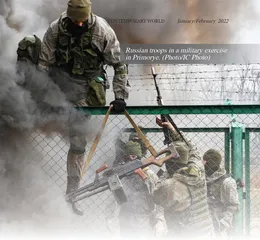International Security Situation in 2021
作者: Tang Yongsheng

The year 2021 witnessed accelerating changes in world situation and the overall stable international security situation. However, with an increased tension and continuous spread of the COVID-19 pandemic, the international security order has been tested and impacted. As a result, instability factors and uncertainty risks in international security have increased. The United States strengthened its support for hegemony. While trying to maintain the original alliance system, it began to build a new security framework, which led to the continued heating of the competition among major powers and resulted in the further tightening of the space for international security cooperation. Geopolitical struggles have triggered tensions and conflicts in some regions, lurking a considerable risk of losing control as well as breeding new differentiation and combination. With many deficiencies in international security governance, the original order fell to be loose and ineffective, and it is hard to set up new norms. In general, the evolving trend of international relations has not changed, and the global demand for promoting cooperation and strengthening coordination has increased accordingly.
Further highlighted political nature of war
Military power is no longer the sole guarantee for maintaining security, and full-scale war is no longer the basic form of war. Even for the United States, a country with powerful military strength, it may be easy to win militarily, but very difficult to obtain political and economic benefits. The United States announced in July 2021 that the U.S. troops would no longer perform important missions in Iraq and had planned to withdraw from Iraq by the end of the year, yet so far it has only completed the so-called “role transformation” from combatants to trainers and advisers. In August 2021, the U.S. military withdrew from Afghanistan in a hurry, followed by the quick take-over of power by the Afghan Taliban. The developments of situation in the Middle East and Afghanistan have all shown that the use of military power in global politics has limitations. One country, even if with absolute advantage in technology and equipment that can destroy the opponent’s personnel and occupy its territory on the battlefield, may fail to achieve substantive victory due to the vague objectives.
Within the current international pattern, the absolute law of war is not fully applicable to the development of global politics. For both politicians and militarists, the strategic decisions made should not be only focused on the victory or defeat on the battlefield, but also on the achievement of their political goals with military power. Especially in local mixed warfare, the goal may not be achieved even if the enemy has been eliminated. The realisation of major strategic objectives should be based on military victories as well as factors other than the victories. Only in this way can we effectively combine military means with political, diplomatic, economic and other means so as to achieve strategic initiative. Even against opponents with poor weapons and weak strength, we cannot solve all problems even with well-equipped and well-trained troops. If we cannot accurately understand the historical evolution of politics and culture of a country or a region, it is difficult to win the final victory. If we can’t well understand the impact and constraints of the development and changes of the global political pattern on the use of military power, it is still likely that we come back in vain no matter how powerful our own strength is.
US military layout intensifying the strategic competition among major powers
The United States intensified the strategic competition among major powers during the Trump administration. This trend has not reversed since Biden took office. On the contrary, it has expanded to a wider extend and wider fields, with a more far-reaching impact. In military, the United States has further strengthened its frontier presence in the Indo-Pacific region and Eastern Europe to ensure that it has sufficient deterrence to meet any challenge. The U.S. has also made efforts to build an even robust defence network by strengthening the military relations with its allies and partners. For a period of time, the U.S. has significantly increased the frequency of the military exercises, spy reconnaissance, bomber flights and other activities along the Russian border and around China. The collision of an American nuclear submarine in the South China Sea also shows that the frequency of relevant U.S. military actions has exceeded the scope of normal geopolitical military activities. The U.S. strategic planning and military deployment have brought signs of dangerous escalation and exacerbated tensions in relevant regions.
U.S. Secretary of Defence Austin fully expounded the “integrated deterrence strategy” of the U.S. military in July 2021. He emphasized the combination of the advantages of the United States and its allies, and the interweaving of technology, operational concepts and various capabilities in the network in an appropriate way, so as to form a reliable, flexible and powerful deterrent capability. Austin also stressed that the United States should no longer only rely on military strength to prevent its opponents from launching an attack. Instead, it should use “integrated deterrence” to force the opponents to retreat. According to this strategic design, the United States will also make some major readjustments to the alliance system and even the entire security framework to strengthen the strategic extrusion and differentiation against its opponents. Since the beginning of 2021, the United States has been accelerating the implementation of the “Indo-Pacific Strategy”, upgrading the Quad formed by the United States, Japan, India and Australia, and attempting to build a “tripartite alliance” of the United States, Britain and Australia. These moves all reflect the importance attached by the Biden administration to coordinating with the allies and partners of the United States to actively reshape the U.S.-led alliance system.